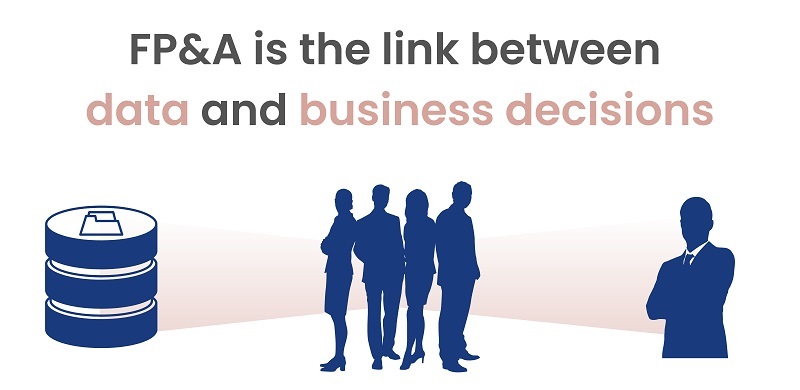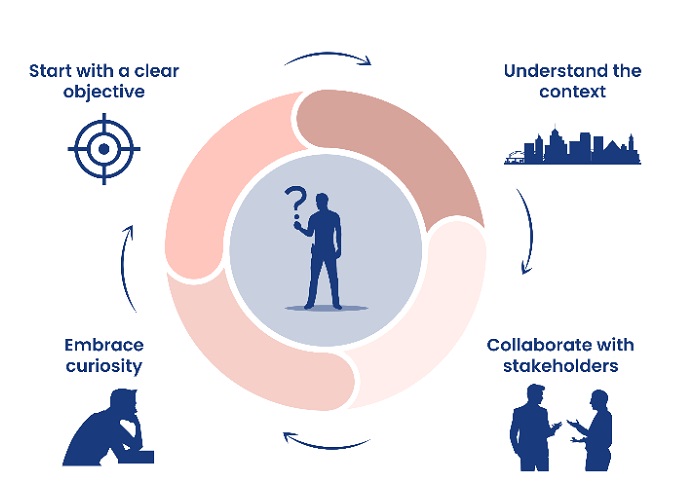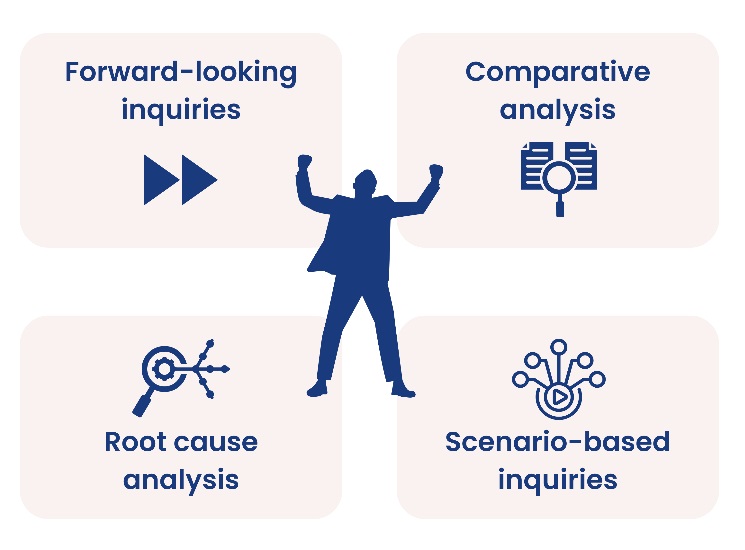Change is inevitable. And a process of change – a story – starts always with a...

"The way I think about it is that FP&A really needs to design the questions we're trying to answer […]"*
When I listened to John McCauley, CFO of Calendly, who said these words, I could not help but link them with my favourite topic: financial storytelling.
Just as financial storytelling enables effective communication of insights, FP&A professionals have a unique responsibility for shaping the questions that drive strategic decision-making.
In this article, we will explore the crucial role of FP&A in designing the question and provide practical insights on how to excel in this aspect.
FP&A as the Translator of Business Language
FP&A professionals have a position in the company that puts them right at the intersection of operations, the business and the data assets.
With this unique position, FP&A must be able to speak the language of the business and understand the data mechanisms that will provide the answers.
FP&A can design questions that align financial insights with the broader organisational strategy by understanding the relations between the various departments and their objectives.

Figure 1. FP&A bridges Data Teams with Decision-Makers
This translation role ensures that financial analysis and recommendations are made with a business and data mindset.
This central position is often seen when business cases are built. For example, a product department has a new launch in mind but needs the Finance function to construct the model for it. It may also need to be in touch with data teams to gather the information FP&A wouldn't have alone.
Is FP&A a Data or a Business Function?
I like to think FP&A is both and none at the same time: while an FP&A professional definitely needs to understand and work with both concepts, I don't see it as an expert in data or business operations.
Historically, in Finance, we've always been more on the side of data and its different tools, e.g. Excel, especially for starters or PowerQuery/BI and all data extractions/transformation tools.
But with the complexity and the quantity of data together with the need of an FP&A function that's ready to step out of its office, come additional challenges: FP&A can't be the best in data handling and structuring and is requested to work more on the operational needs of the company.
I have spent seven years in the Telco industry, and I've seen the amount of data we had to handle almost tripled and become so large in variety and complexity. Simultaneously, the mission of FP&A was slightly turning into a Finance Business Partnering Role.
In that sense, the expertise in data structuring should remain in the hands of data engineering teams. To go even further, the responsibility of writing the queries to get the data, which is now often in the hands of FP&A professionals, should belong to an analytics team.
On the other hand, FP&A remains a co-pilot for business decisions and has an influential and consultative role.
The Significance of Designing the Question
So, what's our role if not getting the data or running the business?
It lies in the fact that we are good on both sides and understand how to formulate the needs of the business and transform those into a language which data professionals will understand.
The quality of insights we bring as strategic advisors strongly relies on the questions we ask. Designing the right question is similar to laying the foundation for a successful data-driven analysis.
It sets the stage for uncovering critical information, identifying trends, and providing actionable recommendations. By crafting well-defined questions, FP&A professionals can drive decision-making processes that may improve financial performance and organisational success.
It leads to a win-win situation for all parties: the business can now explain its requests because we understand how to model their thoughts, while the data teams benefit because we translated the needs knowing the data structure limitations.
The Art of Crafting Effective Questions
Just as a skilled storyteller selects the proper narrative arc, FP&A professionals must possess the ability to craft insightful questions. Here are key behavioural considerations to keep in mind:

Figure 2. Behavioural Considerations to Keep in Mind Before Designing a Question
-
Start with a clear objective
Define the purpose of your inquiry and align it with the organisation's strategic goals. This step is important to assess the scope of the query and to determine the granularity.
-
Understand the context
While it's important to remain open, starting from the hypothesis of the business helps get the information to confirm or infirm this last. The context will also help us understand non-data-related information to complete the request.
-
Collaborate with stakeholders
FP&A is in the middle of other functions and understands both sides of the question. While this could be seen as a customer/provider relationship, it's key to keep collaboration in mind in all aspects: challenging, cooperating and influencing.
-
Embrace curiosity
Cultivate a mindset of exploration and continuous learning, so it will allow you to dig deeper into the subtilities of financial data and uncover hidden patterns.
Designing Questions for Strategic Insights
Designing FP&A questions will strongly relate to the usual concerns of our work and to how we analyse data in an ideal FP&A team:

Figure 3. What to Consider Before Designing Questions for Strategic Insights
-
Forward-looking inquiries
Move beyond traditional reporting by formulating questions that explore future scenarios, potential risks, and growth opportunities. They strongly relate to how we've built the financial/business model.
-
Comparative analysis
Frame questions facilitating comparisons across business units, periods, or virtual scenarios (budget or forecast). In that sense, these scenarios must have the same level of detail.
-
Root cause analysis
Develop questions investigating the underlying drivers behind financial outcomes. The data teams must be prepared to find correlated drivers if that is a key component of your question.
-
Scenario-based inquiries
Pose hypothetical questions that explore various what-if scenarios, enabling proactive planning and mitigating potential challenges. It's generally the most complicated because we need to be complete in the drivers we want to extract and find ways to detect correlations.
Designing Questions in Smaller Structures
Naturally, not all companies nor Finance teams have the privilege of a data analytics team, relieving FP&A from the time to spend extracting data rather than analysing it.
In such cases, we can compare it to how we see Finance Business Partnering: it's more an activity rather than a position in a company.
Therefore, one person can have multiple activities and be compelled to design the question and execute the query to obtain the data.
The key objective will be to bring this mindset into work. Our role as question designers becomes even more crucial in smaller structures, as we must rely on our expertise to extract meaningful information and stay efficient.
Conclusion
Today, in FP&A, designing the business and data questions, as well as being a translator of business language, is a fundamental skill needed to deliver strategic insights to the operations and ensure efficient data requests. While it's the contrary road to financial storytelling, FP&A professionals must use the same mechanism as the ones to build a story. By understanding the context, collaborating with stakeholders, and embracing curiosity, FP&A professionals can shape the questions that lead to efficient decision-making. Ultimately, we use our particular situation between the data and the operations as the bridge leading to the action.
In conclusion, we must reconsider our role and leave the BI tools to the data experts and boost our role as question designers. Ultimately, it will help the business transform its concerns and needs into an explicit request that, in turn, will help us perform our analysis and tell the story behind it.
As FP&A continues to evolve and integrates more and more technology and complex data, mastering the art of designing the question will be a crucial differentiator for us if we want to remain relevant.
Subscribe to
FP&A Trends Digest

We will regularly update you on the latest trends and developments in FP&A. Take the opportunity to have articles written by finance thought leaders delivered directly to your inbox; watch compelling webinars; connect with like-minded professionals; and become a part of our global community.




